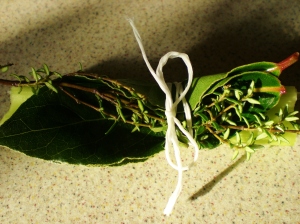Chaud, adjective (chaud (m.), chaude (f.), chauds (m.pl.), chaudes (f.pl)) = hot (pronounced show (for the masculine singular and plural), showed (for the feminine singular and plural).
Du chocolat chaud = hot chocolate; une journée chaude = a hot day; des marrons chauds = hot (roasted) chestnuts; des braises chaudes = hot coals.
The film Some Like it Hot = Certains l’aiment chaud; but the film Cat on a Hot Tin Roof = Chat sur un toit brûlant (literally burning).
The verb chauffer = to heat (je chauffe, tu chauffes, il/elle chauffe, nous chauffons, vous chauffez, ils/elles chauffent = I heat, you heat etc.)
My recipe is for a salade de chèvre chaud = salad with toasted goat’s cheese. Very much a standard starter in French restaurants, or sometimes as a cheese course on longer menus, I have made it a main course by adding this and that.
For two people you will need:
- 2 crottins de chèvre (little round fairly hard goat’s cheeses – see photos)
- 2 slices of wholemeal bread
- some nice, firm lettuce, good and green, not iceberg, or other salad greens of your choice
- a ripe avocado
- a ripe pear
- 10 little slices of smoked duck breast (or petals of parma ham)
- 1 lemon or lime
- olive oil
- salt and pepper
Preparation:
- Prepare the lettuce leaves (or other salad leaves of your choice) and place them on a plate to form a bed for the cheese.
- Peel the avocado and cut it into slices, place half on each plate, squeeze a little lemon juice so that it keeps its colour.
- Peel the pear, cut into chunks, place half on each plate, squeeze a little lemon juice so that it doesn’t go brown.
- Cut the crusts off the bread so that you have two pieces about 7cm square, and toast them. Allow to cool and place on top of the lettuce.
- Place 5 slices of smoked duck breast on each plate in a fan shape (vegetarians just leave out this step).
- Squeeze a little lemon on the lettuce, and drizzle olive oil over the salad ingredients on the plate.
- Season with a little salt and pepper.
- In a small frying pan, put a little olive oil (a teaspoonful, no more) to help the cheese not to stick. Cut each crottin in half horizontally and place in the hot pan, outside skin downwards to begin with. Cook for a minute, and turn with a spatula, very gently. There will be a skin trying to stick to the pan, slip the spatula under this skin so that it is on top when the cheese is turned; cook for a minute on the other side. Again very carefully lift the half crottin, with the skin that will be trying to stick to the pan, and place two halves on top of the bread on each plate. The cheese is not meant to melt all over the place. It should almost keep its shape, just go brown and soften a little.
Bon appétit!










































